

· By James
12 Best Rural Internet Provider Options for 2025
In a world where connectivity is essential, finding reliable internet access outside of urban centers remains a significant hurdle. For remote workers, digital nomads, and families living in rural areas, the search for a stable, high-speed connection often ends in frustration due to limited infrastructure. The good news is that the market is expanding, with 5G home internet and satellite services creating new possibilities where traditional cable and fiber can't reach.
This comprehensive guide is designed to simplify your decision-making process. We will dive deep into the top 12 solutions, including emerging players like SwiftNet Wifi and established names such as Starlink and Verizon. Our goal is to provide a clear, practical roadmap to help you find the best rural internet provider for your unique situation. We'll move beyond marketing claims to analyze real-world performance, pricing structures, and coverage limitations.
Each provider profile includes a detailed breakdown of plans, pros and cons, and honest assessments to help you understand which service truly fits your needs, whether you're streaming movies in an RV or running a business from a remote homestead. We will analyze everything from data caps and latency to equipment costs and contract terms, equipping you with the information necessary to bridge the digital divide and get connected.
1. SwiftNet Wifi
SwiftNet Wifi positions itself as a premier solution for a common modern challenge: securing high-speed internet in areas traditional providers often neglect. By harnessing the power of 5G cellular networks, it delivers a robust connection tailored specifically for rural households, remote professionals, and the dynamic lifestyle of RV travelers. This makes it a formidable contender for the title of best rural internet provider, especially for users who require dependable connectivity for work, education, or entertainment outside of urban centers.
The service's core strength lies in its specialized approach. Instead of offering a one-size-fits-all solution, SwiftNet Wifi focuses on the unique demands of underserved communities and mobile users. This translates to an experience optimized for activities like video conferencing from a remote cabin, streaming high-definition content in an RV park, or simply maintaining a stable connection for daily tasks where fiber or cable are not options.
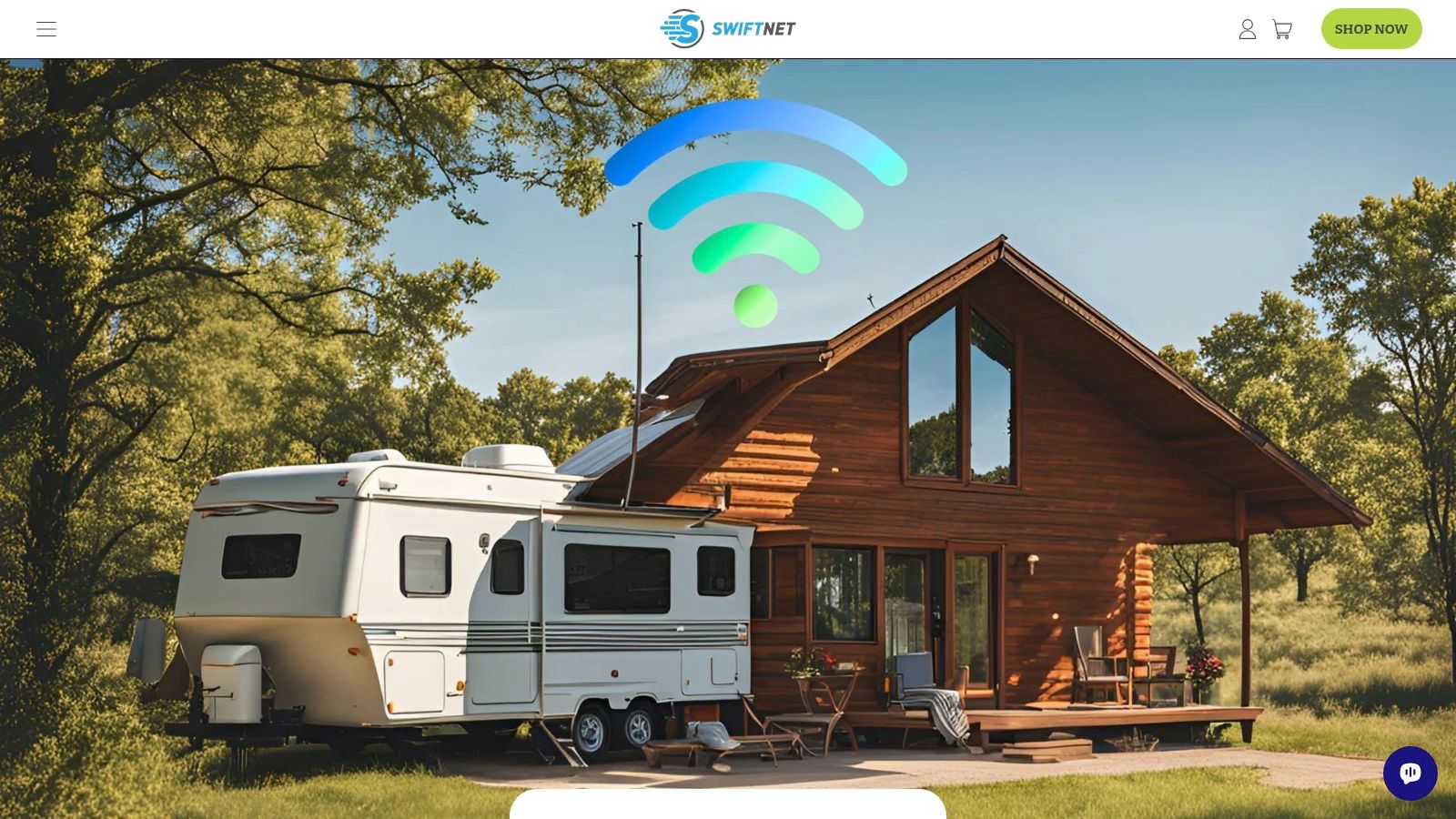
Key Strengths and Use Cases
SwiftNet Wifi excels by providing a practical, high-performance alternative to sluggish satellite or unreliable DSL connections.
- For the Remote Worker: A stable, low-latency 5G connection enables seamless participation in video calls, fast file transfers, and consistent access to cloud-based applications, effectively bridging the productivity gap for professionals living in the countryside.
- For the Digital Nomad/RV Traveler: The service is designed for mobility. Users can maintain a consistent, high-speed internet connection as they travel, transforming their RV into a fully functional remote office or entertainment hub.
- For Rural Families: From online learning and gaming to streaming movies, the service provides the necessary bandwidth to support a modern, connected household, eliminating the frustration of constant buffering and slow downloads.
Practical Considerations
While SwiftNet Wifi offers a compelling service, potential users should note that performance is contingent on regional 5G network availability and signal strength. Pricing is not publicly listed on their website, requiring a direct inquiry to get a quote based on your specific location and needs. This tailored approach, however, ensures you receive a plan optimized for your situation.
Why It Stands Out: SwiftNet Wifi's dedicated focus on both stationary rural homes and mobile RVs with a high-speed 5G-based solution sets it apart. It directly addresses the digital divide with a modern, flexible technology that empowers users to live and work from almost anywhere without compromising on connectivity.
Website: https://swiftnetwifi.com
2. T-Mobile 5G Home Internet
T-Mobile’s website offers a streamlined way for rural residents to access high-speed internet without the need for cable or fiber. The platform’s standout feature is its simplicity and transparency. You can check your address for availability directly on the homepage, eliminating guesswork and long phone calls. This direct approach makes it one of the best rural internet provider options for those who value convenience.
The service leverages T-Mobile's expansive 5G network, offering a single, straightforward plan. This plan includes unlimited data and download speeds typically between 72 and 245 Mbps, suitable for remote work, streaming, and online gaming. The user experience is enhanced by a simple self-installation process; T-Mobile ships a gateway router directly to you, often with free two-day shipping, getting you online quickly.
Key Details & User Experience
- Pricing: A flat rate of $50 per month with AutoPay. T-Mobile's "Price Lock" guarantee ensures this rate won't increase.
- Contracts: No annual contracts, providing flexibility for RV travelers or those with uncertain long-term plans.
- Trial Period: A 15-day free trial allows you to test the service in your specific location without commitment.
- Limitations: Performance can fluctuate based on local network congestion and your home's proximity to a 5G tower. It's less reliable in extremely isolated or mountainous terrain. For an in-depth look at how this technology works, you can explore the specifics of rural 5G internet solutions.
Website: T-Mobile 5G Home Internet
3. Verizon 5G Home Internet
Verizon’s website provides a straightforward gateway for rural households to tap into high-speed wireless connectivity. The platform excels at showing potential customers exactly what they can expect, with an address checker prominently featured to confirm 5G or fixed wireless availability. This direct approach makes Verizon a strong contender for the best rural internet provider, especially for those who already trust the Verizon network for mobile service.

The service utilizes a combination of Verizon’s 5G Ultra Wideband and its LTE Home Internet network to extend coverage. This dual-technology approach ensures that even if you're outside a core 5G zone, you may still qualify for a reliable fixed wireless connection. Plans feature no data caps with download speeds reaching up to 300 Mbps in 5G areas, making it suitable for streaming, remote work, and multi-device households. The included router and simple setup process minimize technical hurdles.
Key Details & User Experience
- Pricing: Starts at $35 per month for existing Verizon mobile customers with AutoPay. Non-customers can expect to pay around $60 per month.
- Contracts: No annual contracts are required, offering great flexibility for renters or those who may move.
- Guarantees: Verizon offers up to a 4-year price guarantee on certain plans, providing long-term budget stability.
- Limitations: While its network is robust, true 5G Home Internet availability is still expanding and can be inconsistent in very remote or geographically challenging rural areas. Plan options are also less customizable than some competitors.
Website: Verizon 5G Home Internet
4. Starlink
Starlink’s website acts as the primary portal for what is arguably the most revolutionary rural internet technology available. Operated by SpaceX, the platform allows users in even the most remote locations to check for service availability and order a complete satellite kit. Its key differentiator is providing low-latency, high-speed internet where terrestrial options are nonexistent, making it a top contender for the best rural internet provider for those completely off the grid.
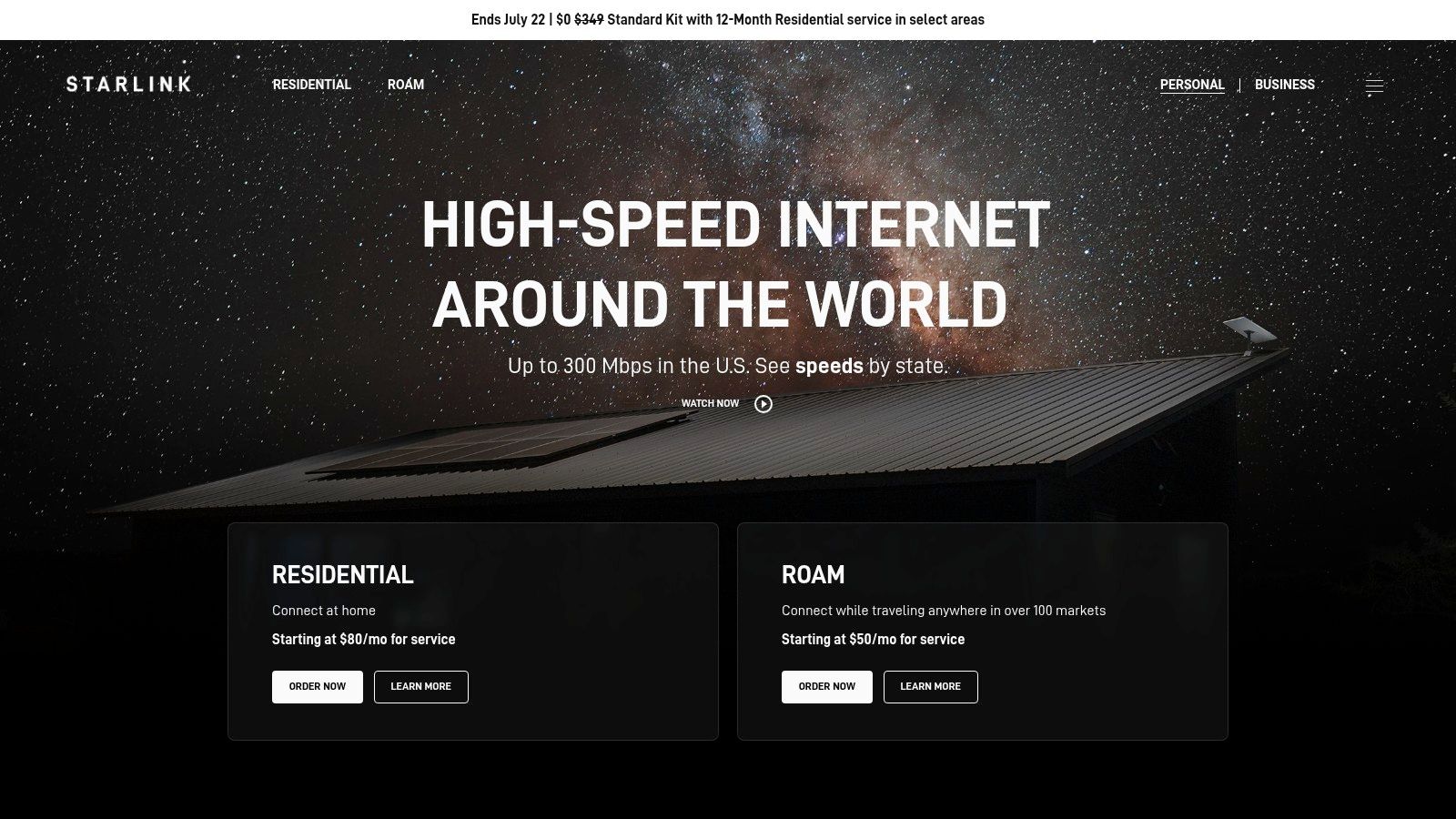
The service utilizes a vast constellation of low-Earth orbit (LEO) satellites, delivering download speeds that can reach up to 220 Mbps. The user experience begins on their site, where you input your address to join a waitlist or place an order. Upon receiving the self-installation kit, which includes the satellite dish (nicknamed "Dishy"), a tripod, and a Wi-Fi router, setup is designed to be straightforward for the average user, getting you connected quickly.
Key Details & User Experience
- Pricing: The standard residential plan costs around $120 per month, with a one-time hardware fee of $599. Mobile plans for RVs and boats are also available at a higher cost.
- Contracts: Starlink operates on a month-to-month basis, offering the freedom to cancel anytime without penalty.
- Trial Period: A 30-day trial period allows you to test the service and return the equipment for a full refund if it doesn't meet your needs.
- Limitations: The high initial equipment cost is a significant barrier for many. Service can be intermittently affected by severe weather, and availability is still being rolled out, sometimes resulting in waitlists in high-demand areas.
Website: Starlink
5. Viasat
Viasat’s website is a crucial resource for anyone in extremely remote locations where terrestrial internet options are nonexistent. The platform clearly explains its satellite technology and allows potential customers to see plans and check availability for their specific address, making it a go-to for those who have exhausted other avenues. Viasat stands out as a best rural internet provider primarily due to its near-universal coverage across the United States.
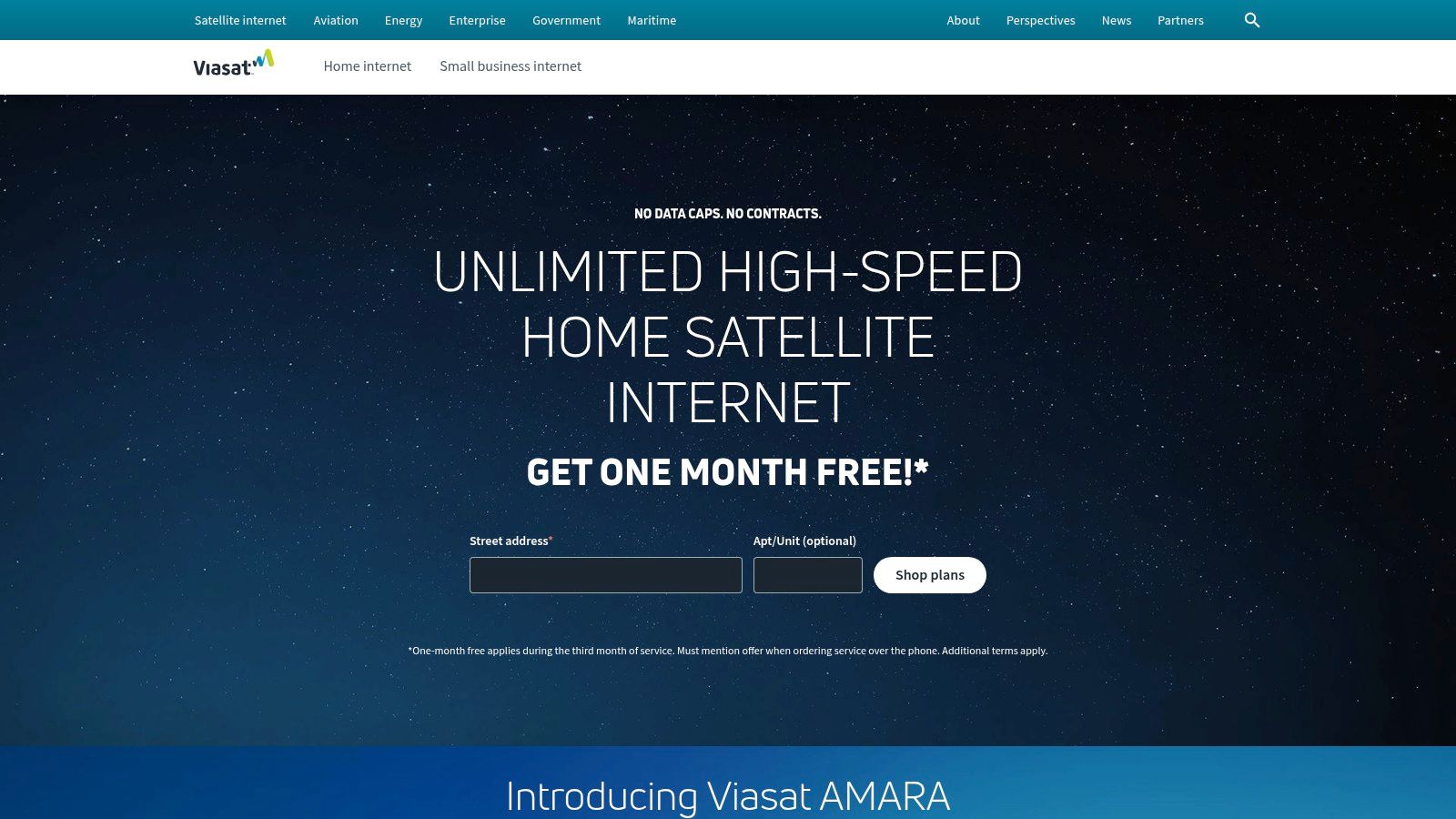
The service provides various plans with download speeds reaching up to 100 Mbps, a significant improvement for users who previously had no high-speed access. The website details different data packages, including unlimited options and a "Bonus Data" feature during off-peak hours. While Viasat solves the core problem of connectivity, it's important to understand the unique characteristics of satellite internet. For a broader overview of connectivity solutions, see these tips for getting internet in rural areas.
Key Details & User Experience
- Pricing: Plan prices vary based on speed and data allowance. Introductory pricing is often available, but be sure to check the standard rate after the promotional period.
- Contracts: Viasat typically requires a 24-month contract, a significant commitment compared to cellular home internet providers.
- Data Allowances: While unlimited plans are offered, they come with a high-speed data threshold. Once exceeded, speeds are significantly reduced.
- Limitations: Satellite internet is susceptible to higher latency, which can affect real-time online gaming and video conferencing. Severe weather like heavy rain or snow can also temporarily disrupt the signal.
Website: Viasat Satellite Internet
6. HughesNet
HughesNet's website provides a crucial lifeline for those in the most remote parts of the country, offering satellite internet where no other options exist. The platform clearly explains how its service works, allowing potential customers to enter their address and see available plans immediately. This direct approach makes HughesNet a contender for the best rural internet provider, especially for households completely cut off from terrestrial networks like cable, DSL, or fiber.
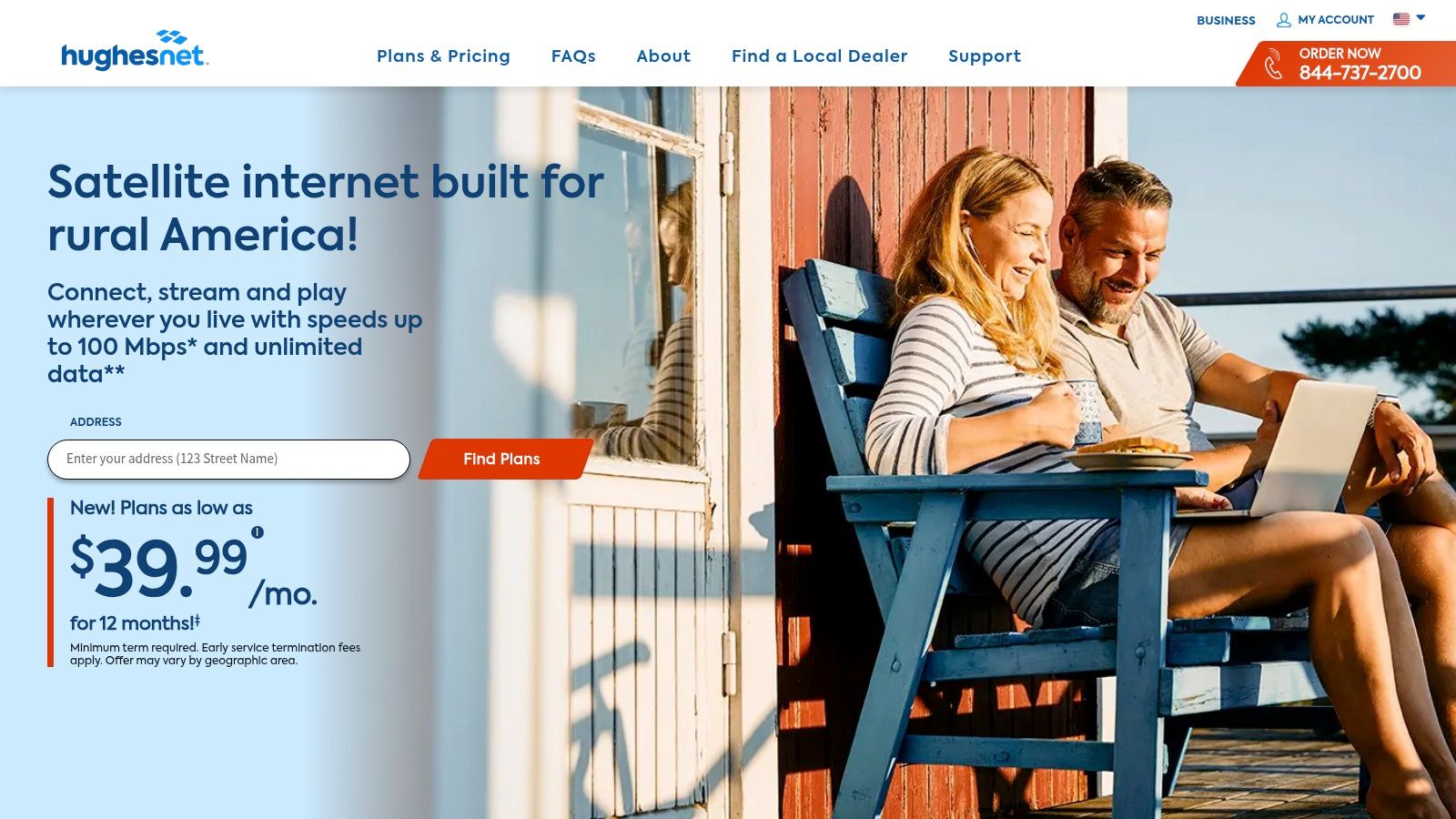
The service delivers connectivity via a satellite dish, providing plans with download speeds up to 100 Mbps. A key feature highlighted on the site is the "Bonus Zone," which offers 50 GB of extra high-speed data during off-peak hours (2 a.m. to 8 a.m.). This is ideal for scheduling large downloads or system updates, helping you conserve priority data for daytime use.
Key Details & User Experience
- Pricing: Plans vary by data allowance and often include introductory pricing. Expect to pay more than cellular or fixed wireless options.
- Contracts: A 24-month contract is typically required, which can be a significant commitment for those needing flexibility.
- Data Caps: While data is technically "unlimited," you have a set amount of priority data. Once used, speeds are significantly reduced.
- Limitations: High latency (the delay in data transmission) makes it unsuitable for real-time online gaming or frequent, high-quality video calls. Service can also be interrupted by severe weather like heavy rain or snow.
Website: HughesNet
7. Rise Broadband
Rise Broadband’s website is a dedicated hub for fixed wireless internet, a technology that delivers broadband to rural and suburban homes that lack cable or fiber infrastructure. The platform immediately focuses on its core strength: providing reliable connections where others can't. Users can quickly enter their address on the homepage to verify serviceability, making it a straightforward process to see if they fall within Rise Broadband's extensive 16-state coverage area. This direct approach makes it a contender for the best rural internet provider for those in its specific service regions.
The service offers download speeds from 25 to 50 Mbps, which is a significant upgrade over traditional satellite for activities like streaming, video calls, and even some online gaming, thanks to its lower latency. A key differentiator is the availability of unlimited data plans, removing the anxiety of data caps common with other rural options. The website also clearly outlines options for premium in-home Wi-Fi and mesh networks, catering to users who need to ensure strong signal quality throughout larger homes or properties.
Key Details & User Experience
- Pricing: Plans vary by location and speed, typically starting around $25-$55 per month. It's essential to check your specific address for exact rates.
- Contracts: Rise Broadband offers plans without long-term contracts, providing valuable flexibility for rural residents.
- Data Allowance: While satellite often imposes strict data caps, Rise offers plans with generous or unlimited data, a major advantage for heavy internet users.
- Limitations: Speeds are lower than fiber or 5G home internet alternatives. As a fixed wireless service, performance can be susceptible to severe weather conditions or physical obstructions like dense trees.
Website: Rise Broadband
8. Mediacom
Mediacom’s website provides a direct pathway for rural households to access cable internet, a technology often more robust than DSL or satellite. The platform’s main function is to confirm serviceability in its specific regions, which primarily include the Midwest and South. For those within its coverage footprint, Mediacom can be the best rural internet provider when high-speed, reliable connectivity for streaming, gaming, and remote work is a priority.
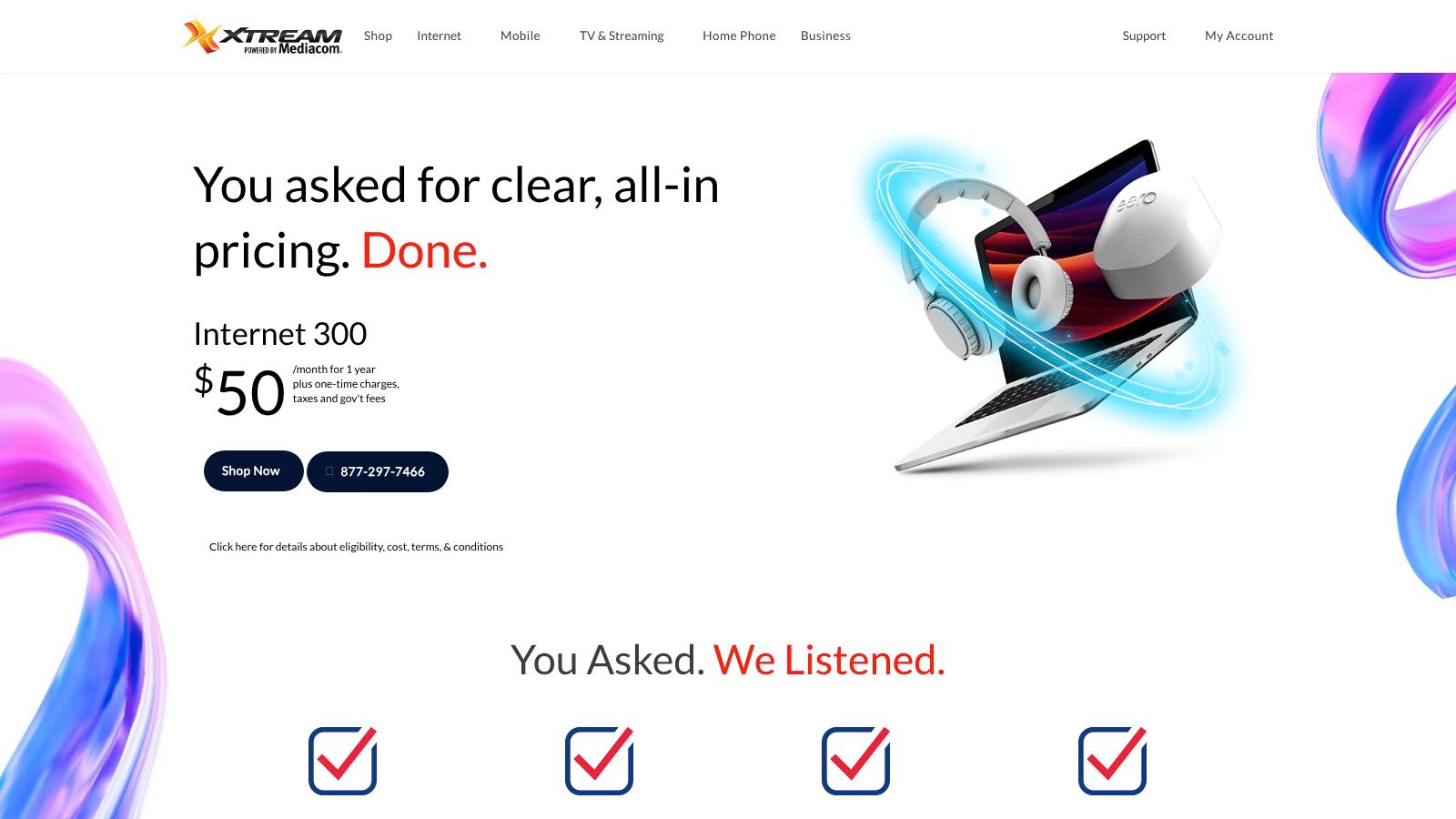
The service offers a range of speeds, from a solid 100 Mbps up to 1,000 Mbps, catering to different household needs and budgets. A significant advantage presented on their site is the absence of contracts, offering flexibility that is rare among traditional cable providers. This makes it an appealing option for residents who may not want a long-term commitment.
Key Details & User Experience
- Pricing: Low introductory rates are a major draw, but be aware that prices increase significantly after the first year.
- Contracts: No annual contracts are required, providing month-to-month flexibility that benefits renters or those with uncertain plans.
- Trial Period: A 90-day money-back guarantee is offered for new customers, allowing ample time to test the service's reliability.
- Limitations: Availability is its biggest hurdle, as service is confined to specific pockets of 22 states. Lower-tier plans come with data caps, and exceeding them can lead to overage fees.
Website: Mediacom
9. AT&T Fixed Wireless Internet
AT&T’s website provides a comprehensive resource for rural users exploring internet options beyond typical cable. The platform clearly presents its fixed wireless, fiber, and DSL services, allowing you to quickly check availability for your specific address. This multi-technology approach makes AT&T a strong candidate for the best rural internet provider, especially for those in areas with varied infrastructure, as it increases the chances of finding a workable solution.
The service is particularly known for its Fixed Wireless option, designed for places where wired connections are impractical. It offers download speeds up to 100 Mbps, making it a viable solution for daily browsing, streaming, and light remote work. A key user-friendly feature is the AT&T Smart Home Manager app, which gives you direct control over your network, a valuable tool for managing device usage and security in a family setting.
Key Details & User Experience
- Pricing: Fixed wireless and DSL plans vary by location and available speed. Equipment fees are typically included in the monthly price.
- Contracts: The service operates on a no-annual-contract basis, offering flexibility for those who may move or wish to upgrade later.
- Data Caps: While fiber plans have no data caps, be aware that Fixed Wireless plans traditionally included data limits, so it's crucial to confirm the specifics for your address.
- Limitations: The best speeds are reserved for their fiber network, which has limited rural availability. DSL and fixed wireless performance can be inconsistent and may not support multiple heavy-use devices simultaneously.
Website: AT&T Fixed Wireless Internet
10. CenturyLink
CenturyLink’s website provides a straightforward gateway for rural customers to find reliable internet, primarily through its extensive DSL network. The platform’s main strength is its wide availability in areas where cable and fiber are non-existent, making it a vital option for many. You can easily enter your address on the site to see what specific plans and speeds are offered in your location, which helps manage expectations from the start.
Its service is particularly suited for individuals in suburban and rural settings who need basic, affordable connectivity. While fiber is available in select areas with speeds up to 940 Mbps, most rural customers will access its DSL service. This makes CenturyLink a solid, if not the fastest, candidate for the best rural internet provider, especially for those prioritizing affordability and widespread coverage.
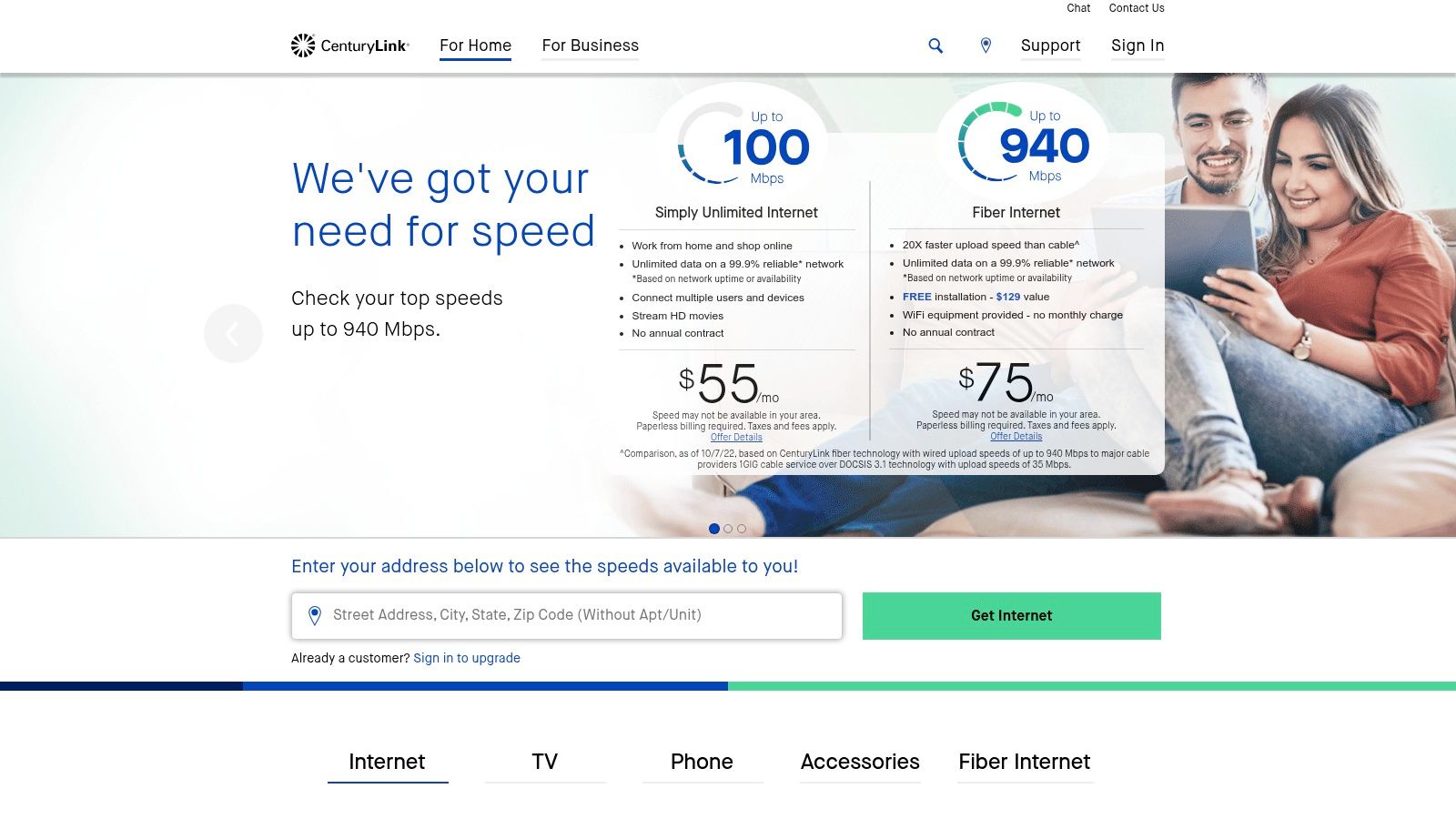
Key Details & User Experience
- Pricing: Plans are often competitively priced, with a focus on providing value without requiring long-term commitments.
- Contracts: CenturyLink is known for its no-contract plans, offering essential flexibility for those who may move or want to avoid being locked in.
- Unlimited Data: Most plans include unlimited data, which is a significant advantage for households that stream, work, or learn from home.
- Limitations: The biggest drawback is the speed disparity. While fiber customers enjoy top-tier speeds, DSL performance is much lower and can vary significantly based on your distance from the central network office. Customer service experiences have also been reported as inconsistent.
Website: CenturyLink
11. Nomad Internet
Nomad Internet’s platform is designed for a specific niche: the truly mobile user. Their website directly addresses the needs of RV travelers, digital nomads, and rural residents who require internet that can move with them. The site's primary function is to match users with a high-speed, portable internet plan powered by major cellular networks, making it a unique contender for the best rural internet provider for those on the go.
The service uses 4G and 5G networks to deliver internet access anywhere with a cell signal. Nomad offers various plans and modem options, providing flexibility that fixed-location providers can't match. This approach is ideal for people whose "home" changes frequently. You simply order a pre-configured modem, plug it in at your new location, and connect to the internet, bypassing the need for professional installation or address-specific service checks.
Key Details & User Experience
- Pricing: Monthly plans vary based on the network and modem chosen, generally starting at a higher price point than fixed wireless services.
- Contracts: Nomad operates on a no-contract basis, which is perfect for seasonal travelers or those who don't want long-term commitments.
- Portability: The equipment is designed to be plug-and-play, making it easy to set up in an RV, cabin, or temporary worksite.
- Limitations: Service quality and speed are highly dependent on local cellular network strength and congestion. Customer support can be less accessible compared to larger providers. For a deeper dive into this type of service, you can explore the top nomad wireless internet options for 2025.
Website: Nomad Internet
12. Focus Broadband
Focus Broadband’s website serves as a gateway for southeastern North Carolina residents to connect with a member-owned fiber cooperative. The platform’s strength lies in its community-centric approach, offering a direct path to check serviceability in specific rural neighborhoods. You can easily input your address on their site to see if their high-speed fiber network, a rarity in many remote areas, is available to you. This local focus makes it a contender for the best rural internet provider for those within its specific service footprint.
The cooperative delivers true fiber-optic internet, offering symmetrical download and upload speeds up to 1 Gbps. This level of performance is ideal for households with demanding needs, such as multiple remote workers, online students, and gamers. The website clearly outlines its straightforward plans and pricing, emphasizing a commitment to transparency with no data caps or hidden fees. Installation is handled by local technicians, reinforcing their community-first model.
Key Details & User Experience
- Pricing: Varies by speed tier, but is competitive for fiber service. Plans are clearly listed on the site.
- Contracts: Flexible options are typically available, reflecting the cooperative’s customer-focused mission.
- Community Focus: As a member-owned cooperative, profits are often reinvested into the network and community.
- Limitations: Service is highly localized and exclusively available in specific counties of southeastern North Carolina. Availability can be limited even within their general territory, and installation fees may apply depending on the location and plan.
Website: Focus Broadband
12 Rural Internet Providers Comparison
| Provider | Core Features / Speeds | User Experience & Quality | Value & Pricing | Target Audience 👥 | Unique Selling Points ✨ |
|---|---|---|---|---|---|
| 🏆 SwiftNet Wifi | High-speed 5G tailored for rural & RV users | Reliable in rural, mobile usage ★★★★☆ | Specialized rural service; pricing via inquiry 💰 | Rural residents, RV travelers, remote workers 👥 | Bridges digital divide; RV-friendly plans ✨ |
| T-Mobile 5G Home Internet | 72-245 Mbps, unlimited data, no contract | Easy self-install, 15-day free trial ★★★☆☆ | Affordable $50/mo autopay 💰 | Rural users seeking no-contract 5G internet 👥 | Broad rural 5G coverage; price guarantee ✨ |
| Verizon 5G Home Internet | Up to 300 Mbps, no data caps | Reliable NE & highways; strong support ★★★★☆ | Up to 4-year price guarantee 💰 | Rural households needing bundles 👥 | 5G+fixed wireless options; included router ✨ |
| Starlink | Up to 300 Mbps, global satellite coverage | Low latency for satellite; no contracts ★★★☆☆ | High initial equipment cost 💰 | Remote users needing global coverage 👥 | Rapid deployment; expanding satellite network ✨ |
| Viasat | Up to 100 Mbps, multiple plans | Wide availability; flexible plans ★★★☆☆ | No long-term contracts 💰 | Rural & remote locations 👥 | Bonus off-peak data; nearly nationwide ✨ |
| HughesNet | Up to 100 Mbps, nationwide satellite | Bonus off-peak data; compatible VoIP ★★☆☆☆ | No contracts; weather-sensitive 💰 | Remote rural users 👥 | Satellite service everywhere; VoIP compatible ✨ |
| Rise Broadband | 25-50 Mbps, unlimited data | Low latency; easy setup ★★★☆☆ | No contracts; better data than satellite 💰 | Rural & suburban broadband users 👥 | Fixed wireless; mesh network options ✨ |
| Mediacom | 100 Mbps to 1 Gbps, no contracts | Faster than DSL/satellite ★★★★☆ | Low intro rates; price hikes after 1st year 💰 | Rural users wanting cable speeds 👥 | High speeds; no contracts ✨ |
| AT&T Fixed Wireless | Up to 100 Mbps; fiber and DSL options | Strong support; no annual contracts ★★★☆☆ | Equipment fee included; fiber limited 💰 | Rural areas needing mixed tech options 👥 | Smart Home Manager app; multiple tech ✨ |
| CenturyLink | Up to 940 Mbps, unlimited data | Reliable with wide availability ★★★☆☆ | Affordable, no-hidden fees 💰 | Rural and suburban users 👥 | No contracts; 24/7 support ✨ |
| Nomad Internet | Up to 500 Mbps, no data caps | Portable, plug-and-play devices ★★★☆☆ | Higher monthly costs 💰 | Nomads, RV & mobile home users 👥 | Portable 4G/5G; flexible plans ✨ |
| Focus Broadband | Up to 1 Gbps fiber-optic | Local support; community focused ★★★★☆ | Competitive pricing 💰 | Rural SE North Carolina communities 👥 | Member-owned cooperative; fiber optic ✨ |
Making the Right Connection for Your Rural Home
Navigating the landscape of rural internet can feel overwhelming, with a diverse mix of technologies and providers each claiming to be the solution. As we've explored, the title of "best rural internet provider" isn't a one-size-fits-all award. Instead, it's a personalized choice that hinges directly on your specific location, your daily online activities, and your tolerance for certain trade-offs, like higher latency for universal coverage.
The key takeaway from our detailed comparison is that your physical address is the single most important factor. It dictates which technologies are even available to you, narrowing your options from a dozen possibilities down to just a handful. While satellite options from Starlink, Viasat, and HughesNet offer a lifeline to the most remote locations, the rapid expansion of 5G home internet from providers like SwiftNet Wifi, T-Mobile, and Verizon is providing unprecedented speed and reliability in previously underserved areas.
A Practical Framework for Your Decision
Making the right choice requires a methodical approach. Don't get swayed by a single flashy speed number or a low introductory price. Instead, use this framework to guide your final selection:
-
Verify Availability First: Before you do any other research, use the online availability tools for every provider on our list. This is the crucial first step that creates your personal shortlist. Don’t just check your address; check with neighbors to see what they use and their real-world experience.
-
Define Your "Why": Be honest about your primary internet usage. Are you a remote worker needing stable video calls (low latency is key)? A family that streams 4K movies nightly (high speed and data caps matter)? Or a casual user who just needs to check email and browse the web (basic plans will suffice)? Your "why" determines which specifications are most important.
-
Assess the True Cost: Look beyond the monthly fee. Consider one-time equipment costs, installation fees, contract lengths, and potential price hikes after a promotional period. A provider like Starlink has a high upfront cost, while some fixed wireless options may have none. Factor this into your budget.
-
Consider Your Mobility: For RV travelers and digital nomads, portability is a paramount concern. Providers like Starlink for RVs and cellular-based options from Nomad Internet or SwiftNet Wifi are designed for life on the move, offering flexibility that traditional satellite or fixed wireless simply cannot match.
Final Thoughts on Finding Your Connection
The digital divide is shrinking, and securing a reliable, high-speed internet connection in a rural area is more achievable today than ever before. Gone are the days when your only option was slow, unreliable satellite with crippling data caps. The rise of 5G, low-Earth orbit satellites, and competitive fixed wireless services has created a dynamic and competitive market.
Finding the best rural internet provider for your home or RV is an empowering process. It's about taking control of your digital access and enabling a lifestyle that doesn't require sacrificing connectivity for location. Use the insights from this guide as your foundation, do your localized research, and make the choice that unlocks your full online potential, no matter how far you are from the city lights.
Ready to experience high-speed, reliable internet designed for rural living and the open road? SwiftNet Wifi leverages the power of major cellular networks to deliver an exceptional connection where traditional providers fall short. Check your availability and discover a better way to connect with SwiftNet Wifi today.

